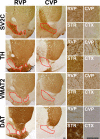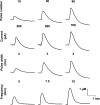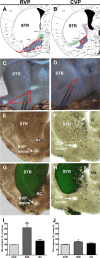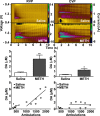Selective Enhancement of Dopamine Release in the Ventral Pallidum of Methamphetamine-Sensitized Mice
- PMID: 27501345
- PMCID: PMC5073372
- DOI: 10.1021/acschemneuro.6b00131
Selective Enhancement of Dopamine Release in the Ventral Pallidum of Methamphetamine-Sensitized Mice
Abstract
Drugs of abuse induce sensitization, which is defined as enhanced response to additional drug following a period of withdrawal. Sensitization occurs in both humans and animal models of drug reinforcement and contributes substantially to the addictive nature of drugs of abuse, because it is thought to represent enhanced motivational wanting for drug. The ventral pallidum, a key member of the reward pathway, contributes to behaviors associated with reward, such as sensitization. Dopamine inputs to the ventral pallidum have not been directly characterized. Here we provide anatomical, neurochemical, and behavioral evidence demonstrating that dopamine terminals in the ventral pallidum contribute to reward in mice. We report subregional differences in dopamine release, measured by ex vivo fast-scan cyclic voltammetry: rostral ventral pallidum exhibits increased dopamine release and uptake compared with caudal ventral pallidum, which is correlated with tissue expression of dopaminergic proteins. We then subjected mice to a methamphetamine-sensitization protocol to investigate the contribution of dopaminergic projections to the region in reward related behavior. Methamphetamine-sensitized animals displayed a 508% and 307% increase in baseline dopamine release in the rostral and caudal ventral pallidum, respectively. Augmented dopamine release in the rostral ventral pallidum was significantly correlated with sensitized locomotor activity. Moreover, this presynaptic dopaminergic plasticity occurred only in the ventral pallidum and not in the ventral or dorsal striatum, suggesting that dopamine release in the ventral pallidum may be integrally important to drug-induced sensitization.
Keywords: Dopamine; methamphetamine; sensitization; ventral pallidum; voltammetry.
Conflict of interest statement
The authors declare no competing financial interest.
Figures







Similar articles
-
Significance of glutamate and dopamine neurons in the ventral pallidum in the expression of behavioral sensitization to amphetamine.Life Sci. 2001 Jan 19;68(9):973-83. doi: 10.1016/s0024-3205(00)00995-4. Life Sci. 2001. PMID: 11212872
-
Differential changes in synaptic terminal protein expression between nucleus accumbens core and shell in the amphetamine-sensitized rat.Brain Res. 2001 May 18;901(1-2):175-83. doi: 10.1016/s0006-8993(01)02347-2. Brain Res. 2001. PMID: 11368965
-
Ventral pallidal injections of a mu antagonist block the development of behavioral sensitization to systemic morphine.Synapse. 2000 Oct;38(1):61-70. doi: 10.1002/1098-2396(200010)38:1<61::AID-SYN7>3.0.CO;2-6. Synapse. 2000. PMID: 10941141
-
Implication of activated astrocytes in the development of drug dependence: differences between methamphetamine and morphine.Ann N Y Acad Sci. 2008 Oct;1141:96-104. doi: 10.1196/annals.1441.032. Ann N Y Acad Sci. 2008. PMID: 18991953 Review.
-
Mechanism of action of methamphetamine within the catecholamine and serotonin areas of the central nervous system.Curr Drug Abuse Rev. 2012 Sep;5(3):227-42. doi: 10.2174/1874473711205030227. Curr Drug Abuse Rev. 2012. PMID: 22998621 Review.
Cited by
-
Shared Behavioral and Neurocircuitry Disruptions in Drug Addiction, Obesity, and Binge Eating Disorder: Focus on Group I mGluRs in the Mesolimbic Dopamine Pathway.ACS Chem Neurosci. 2019 May 15;10(5):2125-2143. doi: 10.1021/acschemneuro.8b00601. Epub 2019 Apr 15. ACS Chem Neurosci. 2019. PMID: 30933466 Free PMC article. Review.
-
Ventral pallidum DRD3 potentiates a pallido-habenular circuit driving accumbal dopamine release and cocaine seeking.Neuron. 2021 Jul 7;109(13):2165-2182.e10. doi: 10.1016/j.neuron.2021.05.002. Epub 2021 May 27. Neuron. 2021. PMID: 34048697 Free PMC article.
-
Chemogenetic Manipulations of Ventral Tegmental Area Dopamine Neurons Reveal Multifaceted Roles in Cocaine Abuse.J Neurosci. 2019 Jan 16;39(3):503-518. doi: 10.1523/JNEUROSCI.0537-18.2018. Epub 2018 Nov 16. J Neurosci. 2019. PMID: 30446532 Free PMC article.
-
Vesicular monoamine transporter 2 mediates fear behavior in mice.Genes Brain Behav. 2020 Jun;19(5):e12634. doi: 10.1111/gbb.12634. Epub 2020 Jan 14. Genes Brain Behav. 2020. PMID: 31898856 Free PMC article.
-
A Neurodevelopmental Model of Combined Pyrethroid and Chronic Stress Exposure.Toxics. 2019 May 2;7(2):24. doi: 10.3390/toxics7020024. Toxics. 2019. PMID: 31052489 Free PMC article.
References
-
- Substance Abuse and Mental Health Services Administration, Results from the 2013 National Survey on Drug Use and Health: Summary of National Findings, NSDUH Series H-48, HHS Publication No. (SMA) 14–4863. Substance Abuse and Mental Health Services Administration, Rockville, MD, 2014.
-
- U.S. Department of Health and Human Services. The Health Consequences of Smoking—50 Years of Progress: A Report of the Surgeon General, U.S. Department of Health and Human Services, Centers for Disease Control and Prevention, National Center for Chronic Disease Prevention and Health Promotion, Office on Smoking and Health, Atlanta, GA, 2014.
-
- Drug Enforcement Agency Strategic Intelligence Section. National Drug Threat Assessment Summary. DEA-DCT-DIR-008-16. U.S. Department of Justice, Washington, DC, 2015.
Publication types
MeSH terms
Substances
Grants and funding
LinkOut - more resources
Full Text Sources
Other Literature Sources
Medical

